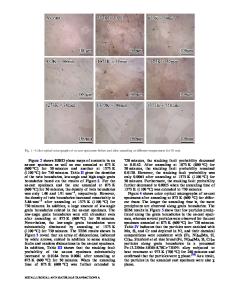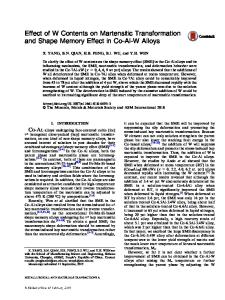A phenomenological study of the shape memory effect in polycrystalline uranium-niobium alloys
- PDF / 952,228 Bytes
- 9 Pages / 594 x 774 pts Page_size
- 106 Downloads / 305 Views
IN elemental uranium, the body-centered-cubic allotrope, y, is stable only at elevated temperatures and spontaneous transformation to non-cubic crystal structures can not be suppressed by quenching? The addition of certain alloying elements has been adopted as one method for broadening the temperature range of y-phase stability. Alloys of U containing N b 1) show complete solubility but only at very high temperatures in the 7 phase; 2) form a y-phase miscibility gap at moderately high temperatures; and 3) in uranium-rich alloys decompose monotectoidally at temperatures below 920 K ? When alloys near the monotectoid composition ( ~ 14.5 at. pct Nb) are quenched rapidly from the y-phase, however, diffusion-controlled precipitation producing a nearequilibrium product of a-U plus a Nb-rich 7 can be averted: alternate metastable phases are formed instead. Alloys containing less than 9 at. pct Nb transform on quenching to room temperature to an orthorhombic phase similar to unalloyed U :3.4but because this phase is supersaturated and its lattice parameters differ from the pure metal, it has been designated ~'. For compositions between 10 and 20 at. pct Nb, quenching results in the formation of one or the other of two additional transition phases. 3.5 Either a monoclinic distortion of a', called ~", or a tetragonal distortion of 7, R. A. VANDERMEER, formerly with Metals and Ceramics Division, Oak Ridge National Laboratory, is now Senior Staff Metallurgist, DevelopmentDivision, Y-12 Plant, Oak Ridge, TN 37830. J. C. OGLE is Metallurgist, Metals and Ceramics Division, Oak Ridge National Laboratory~Oak Ridge, TN 37830. W. G. NORTHCUTT, JR. is Metallurgist, Development Division, Y-12 Plant, Oak Ridge, TN 37830. Manuscript submitted May 30, 1980. METALLURGICALTRANSACTIONSA
named y~ are formed at the low and high ends of the composition range, respectively. The reactions producing a" and y~ regarded generally as martensitic in nature, occurring by shear a n d / o r disptacive mechanisms. 6'7 Furthermore, in several investigationr '8'9 evidence was presented suggesting that the reaction path for these diffusion-less transitions proceeded progressively as 7(bcc) ~ y~ a'(monoclinic) --9 a'(orthorhombic) Indeed several rudimentary theoretical models have been proposed to explain such a sequential path. m~ In a recent study ~2of a U + 14 at. pct Nb alloy, y phase transformation to a " was observed dilatometrically during rapid cooling from 1075 to 300 K. The transformation occurred in two stages in substantial agreement with the first two steps in the above mentioned scheme. When deformed in an apparently plastic manner in the a" state and subsequently reheated, this alloy displayed a sizable shape m e m o r y effect (SME). 13A4Uniaxial tensile strains of up to 7 pct were recovered upon unloading and upon subsequent reheating to cause reversion of a " to the y-phase. Most but not all of the heat-activated shape recovery accompanied the reversion of a " to 7~ (the supposed intermediate state in the forward transformation). While SME
Data Loading...











